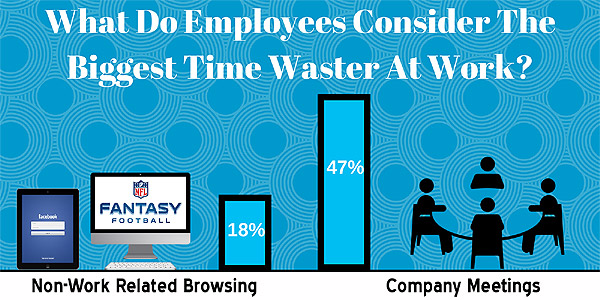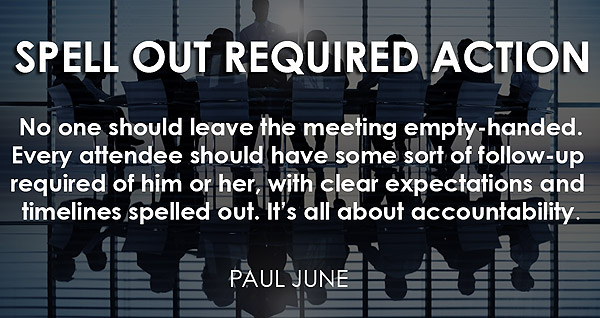We’ve all been there: meetings that are at conceivably the worst times possible, lack focus, just seem to go on endlessly with little to show for progress, or tend to become forums for self-aggrandizement.
- It’s Monday morning and someone had the bright idea to kick off the week with an early morning meeting. So-and-so, who tends to drone on and on, is doing his best impersonation of the adult “mwa-mwa-mwa-mwa” voice from the old Charlie Brown cartoons. If you’re not careful, you just might return to your blissful slumber of just a few hours ago. Luckily, you had the foresight to stop for a 20-oz high-octane coffee on the way in.
- It’s late Friday afternoon. Your family awaits you at home so you can all embark on a weekend getaway, only someone has scheduled a meeting at the last minute. Luckily, so-and-so isn’t here, but what’s-her-name is, and she has more energy than any human should be allowed to have on a Friday afternoon . . . and she just wants to keep going and going and going with new ideas, new topics, and a whole lot of “wouldn’t it be great ifs.” You notice you’re not the only one stealing a glance at your watch.
- A colleague, who you’ve nicknamed “Laurence” (as in Olivier) is at it again—using the meeting as a personal self-promotion platform rather than an actual forum. It’s all about him and his team, rather than what needs to get done . . . and the act is getting old. Can’t anyone take charge? Won’t anyone speak up?
If any of these scenarios sounds familiar, you are not alone. A 2012 article from HR News Daily reveals that 47% of employees say that meetings are the biggest time wasters at work, compared to only 18% for accessing the internet for non-work related content, accounting for billions in lost productivity. With numbers like that and corporate profits still shaky after the “Great Recession,” boosting the effectiveness of your meetings sure seems like a no-brainer to me (talk about low hanging fruit)!

I’m a marketer at heart. It’s in my blood and it’s my career path. It should come as no surprise then that I tend to view meetings with a marketing mindset:
- What conditions have led to the need for this meeting (pain points)?
- When does this meeting need to happen to be most effective (timing)?
- Who’s the target audience (who absolutely needs to be there)?
- What do participants (including me) hope to get out of the meeting (expectations)?
- How can meeting content/messages be delivered in a way that connects with participants?
- What do I want attendees to take away, do as a result of this meeting (call to action)?
- How will I know the meeting has been a success?
- Is this a one-and-done meeting, or will we need additional sessions (frequency)?
- What happens after the meeting? What’s next?
The only thing worse than NOT holding a meeting when one is necessary, is to hold a meeting that wastes people’s time and talent and energy. In some circles, bad meetings are the stuff of office legend . . . and the fear of many a potential participant.
Below are some of this King Monkey’s ideas on how you can get more out of your meetings so they deliver consistently. This clearly is not an exhaustive list, and I don’t really dabble in the “parliamentary procedure” aspect of meetings. That’s just a little too constricting for me. Instead, these suggestions are more big picture in nature and apply to in-person as well as virtual (phone/Web) meetings.
- As with marketing, timing is everything. When should you hold your meetings? Chances are, if you run on a traditional, Monday through Friday, 9 to 5 schedule, first thing Monday morning and end-of-day Friday are probably the least favorable times for productive meetings. Either people will be just getting back into work mode after the weekend break, or they will be ready to “coast” late in the week. I tend to find the Tues-Wednesday-Thursday window most effective, especially in mid-morning or mid-afternoon.
- Start your meetings on time and end them promptly. Avoid “where is everybody?” scenarios or having attendees begin to wonder, “Will this ever end?” Indicate a clear beginning time and end time, and if the business of the meeting can’t be conducted within that window, schedule a follow-up. Meetings that take all or half of the day are rarely productive as the hours drag on. Invariably, attendees suffer from meeting fatigue and begin to think of all the “real” work they have to get done once the meeting ends!
- Set expectations before the meeting. You don’t want your attendees wondering, “Why am I here?’ or “What do we want to accomplish?” Send out a meeting agenda or email that properly sets the stage.
- Keep meetings simple. At most, meetings should have 2 or 3 critical goals (or better yet, just one), that are clearly spelled out ahead of time so participants can prepare. If you’re meeting can’t be made simple, that’s probably a clear indicator you need separate meeting to address other topics.
- If you’re in charge of the meeting, be in charge. Don’t be rude, but if someone is dominating the meeting or using it as his or her self-promotional platform, step in and redirect the conversation.
- Don’t be afraid to laugh or crack a joke. Varying speech patterns and speed, not to mention injecting a little humor now and then, can go a long way to keeping energy levels up and people tuned in. From boring college professors to flat-voiced CEOs, we’ve all been there . . . and we don’t ever want to go back.
- Make sure people got what they needed. Before breaking, summarize what you think was said or accomplished, and ask others to confirm what you heard or correct you.
- Spell out required actions or follow-up. No one should leave the meeting empty-handed (if someone does, that person probably didn’t need to be there). Every attendee should have some sort of follow-up required of him or her, with clear expectations and timelines spelled out. It’s all about accountability.

- Switch up venues and routines. Change your meeting place from time to time. Ditch the stuffy old boardroom and go off site. Meet in the hallway, the break room, or in the park! Don’t sit in the same chair all the time. If you’re video conferencing, give others something fun to look at in the background instead of a plain white wall. Variety is the spice of life; it can also add some spice to your meetings and keep participants energized!
- Vary how you deliver meeting content. These days you shouldn’t have to work hard to set up various multimedia platforms to deliver meeting content. Whether it’s a PowerPoint, a YouTube video you think everyone should see, a Web site, an audio recording, a Webinar, or even a taste test with free samples, don’t be afraid to engage the senses. People learn and hear and process information in different ways, and they’ll appreciate not having to listen to you (or some other speaker) run through the latest 10 bullet points on a piece of paper every time you meet. The change of pace will engage people and make them more likely to anticipate your meetings rather than avoid them.
- Sometimes the best meetings are spontaneous ones. When the moment arises, don’t wait. Have the meeting right on the spot while the topic is fresh. Cover it and move on quickly!
Meetings don’t have to be the dreaded “M” word. Meetings can be creative. Meetings can be a source of ideas, or a place to share them. And meetings can be fun.
What’s your worst meeting horror or success story? Have there been times when a meeting went particularly well? What made it so? If there’s been a time that a meeting went bad, why was that?
Share your experiences here.
For additional reading on the topic, check out Boring Meetings Suck by John Petz and Make Meetings Work by Michael Doyle.
